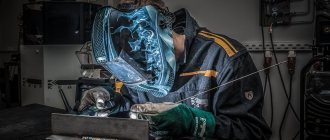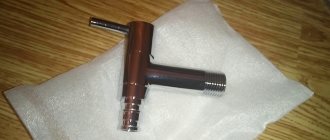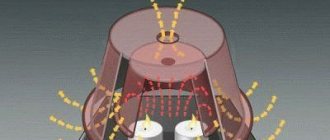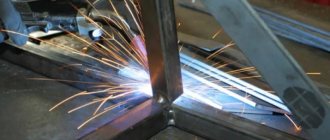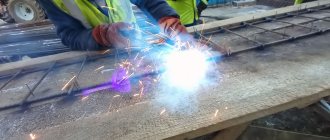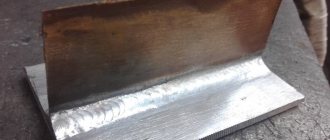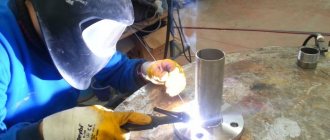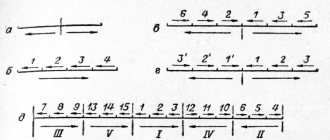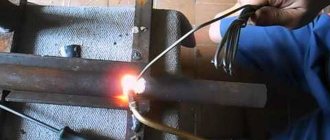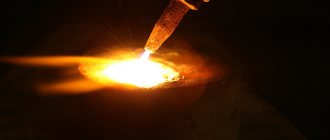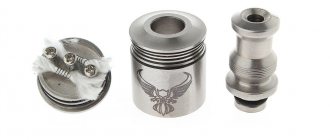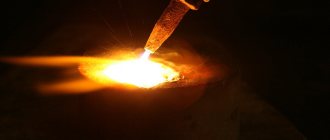Introduction
Heating elements made of high-resistance alloys based on chromium and nickel are used in all modern household devices designed to convert electricity into heat. Nichrome spirals or tapes are highly resistant to oxidation due to the formation of oxide films. For this reason, reliable soldering of nichrome heaters in the absence of special equipment (vacuum chambers, gaseous media) should be carried out after treating the surfaces to be joined with fluxes, which contain acids that can destroy the protective layer of oxides. Nichrome spirals last longer than their analogues made of fechral alloys, however, they are also subject to destruction during long-term use. The likelihood of burnouts and breaks increases in areas of the conductor where there are mechanical damage, nicks, kinks or overlaps with the surface of adjacent heating elements. Repairing a damaged nichrome spiral can be done at home. If simple technologies are followed, the operational characteristics of electrical equipment will be completely restored.
"Little tricks". Part 3.
How to extend the life of a soldering iron
Like an incandescent lamp, soldering irons have a spiral - a heating element. As a rule, it burns out when the soldering iron is turned on, less often - when it is turned off. During long (time-consuming) installation work, it is not advisable to turn off the soldering iron, but sometimes it is enough to just limit the heating.
To do this, a button (with fixation) with contacts for closure is inserted into the break in the electrical circuit “network - heating coil”. And in parallel with this button, a rectifier diode of type D226B - D226Zh, KD213 or similar is turned on.
When the button contacts are open (but the plug is plugged in), limited heating of the soldering iron coil occurs. One has only to close the contacts of the button, and the heating goes “in full force”. At the same time, the soldering iron heats up faster, because it was already ready for use. Using this method, it is possible to significantly extend the “life” of the soldering iron!
How to connect high-resistance nichrome wires
A simple method can be used to ensure reliable electrical contact in wires made of high resistance alloys (nichrome, constantan). To do this, the wires at the junction are stripped and twisted. Then such a current is passed through them that the junction becomes red hot. You need to put a piece of lapis in place of the twist. When heated, it will melt and provide reliable electrical contact at the junction.
How to solder contacts made of stainless steel, chrome and nickel
When the material is difficult to solder, you need to use soldering acid or aspirin. In this case, it is necessary to preheat the soldering area until scale appears.
Another method of soldering such metals is a little simpler. It is necessary to thoroughly clean and degrease the soldering area. Then tin and spread with glue like BF-4 (or similar). After this, use the tip of a heated soldering iron to press the surfaces to be soldered for 5-7 seconds. After cooling, apply a drop of instant glue to the soldering area to completely harden the contact.
How to solder aluminum parts
It is not difficult to solder the leads of radio components or the ends of conductors to a copper, brass or steel surface. But try to do this on an aluminum chassis and you will see that the solder will not even stick to its surface. The reason is an oxide film - the result of the combination of aluminum with oxygen in the air. This film prevents the solder from joining the metal.
The oxide film can be removed electrochemically. Stock up on saturated copper sulfate, a 3336 battery (or power supply) and copper wire without enamel insulation. Thoroughly clean the area of the intended soldering of parts or conductors on the aluminum surface and carefully apply 2-3 drops of copper sulfate. Connect a conductor from the negative terminal of the battery (power supply) to the chassis, and connect a piece of copper wire to the positive terminal. Dip the end of the wire into a drop of vitriol on the chassis (the wire should not touch the aluminum). After some time, a layer of red copper will settle on the chassis, to which, after drying, you can solder the leads of the parts.
How to prepare conductive glue
Tsaponlak and graphite from any battery (central rod) are mixed until sour cream is thick, a thin layer is applied. Can be used to restore graphite tracks on remote controls and other similar devices.
Repair of nichrome spiral
There are 3 ways to restore the integrity of a nichrome conductor:
- Mechanical - twists, couplings, threaded clamps using washers, screws and nuts.
- Soldering.
- Welding.
The latter method is the most reliable in terms of strength and durability. Welded connections do not significantly affect the parameters of electrical circuits, so the technical characteristics of the devices remain the same. Connections in the form of twists, couplings and clamps create conditions for the accumulation of oxidation products, affect the overall resistance of the circuit, and can also create areas of increased heating, which increases the risk of repeated breaks and failure of electrical equipment.
How to weld nichrome
In production, the argon arc method is used for reliable welding of nichrome wire or tape. However, small diameter wires that are used as heating coils in household appliances can be welded using a homemade welding system at home. This will require a 12-24 V power source with a current of 10 amperes or higher. You can use the graphite rod of a salt battery as an electrode. The connecting ends of the heating coil are twisted. The negative wire from the power source is connected to the nichrome wire. A graphite rod is connected to the positive wire through the choke of the fluorescent lamp. When the graphite touches the welding area, a low voltage arc appears, the energy of which will be enough to melt the nichrome.
What electrodes are used
When performing manual arc welding of nickel and its existing alloys, it is necessary to use electrodes that are characterized by high-quality coating. The highest quality welded joint is provided by coated electrodes of the “Progress-50” type . Such electrodes are used for welding nickel, as a material having grades N-1, NP-1, NP-2. If we talk about electrodes coated with ENHD-10, they are used for the manufacture of welded joints of parts made of nickel-silicon alloys. Electrodes coated with ENKhM-100 are designed for connecting parts made of nichrome and nickel-molybdenum alloys. For welding alloys of the types KhN80TBYu, KhN80TBYuA, KhN70VMTYu and KhN75MVTYu, coated electrodes of the IMET and VI-2-6 types are used.
How to solder nichrome
You can solder a nichrome spiral in the following ways:
- Heating of the winding in the form of thin copper wire.
- Use of lapis (silver nitrogen).
- The use of special solders and acid-containing fluxes.
- A mixture of petroleum jelly, glycerin and zinc chloride.
- Lemon acid.
- Aspirin.
- Factory-made fluxes, type F-38N PET.
- Measurement using instruments.
- Tabular method.
The first method is the simplest and most accessible, but it is only suitable for connecting high-resistance conductors with a thickness of no more than 0.5 mm. It is best to take copper wire for winding with a thickness of 0.1 mm. Heating is done using a gas burner, but you can also use a regular turbo lighter. The copper wire heats up red hot and sticks to the nichrome, creating electrical contact at the atomic level.
The soldering method using lapis is used to strengthen the contact of mechanical twisting if the operating temperature of the heating element in the device does not exceed 200 °C (the fusion limit of silver nitrate). The substance is applied to the twist when it is heated by electric current. The most reliable results are obtained by soldering using special solders and fluxes. The oxide film that forms on the surface of chromium-nickel spirals is the main obstacle to high-quality tinning. In industrial production conditions, to solve this problem, it is advisable to use vacuum chambers or neutral gas environments.
At home, acid-containing fluxes are used: the surfaces to be joined are cleaned of the oxide film, degreased and coated with fluxes using a soldering iron. After this, preliminary tinning and soldering are carried out using POS 40/50/61 solders.
How can you increase the current so that the nichrome thread heats up?
Hello, my old Soviet soldering iron burned out. I have nichrome thread from electric kettles and stoves and I want to rewind it. There is a 12 volt power supply from the ultrasonic rodent repeller, but the current is low (150mA). Nichrome thread does not heat up. How to increase the current strength or maybe you can recommend something else. I want to say right away that I am not good at electrical engineering.
Share on social networks
Comments and reviews (8)
Alexei
Your power supply is very low power, I have not seen a 1.5 W soldering iron, even a USB soldering iron is more powerful. Take the thread from your burnt soldering iron, 10% of the total length, wind it on a polished ceramic tube from a 0.5W resistor, or a tubular capacitor, oblong form factor, Soviet-made. They gave it inside, made of copper wire of a suitable diameter.
In burners, like burners, the power on nichrome is 10-20 watts. tested and done a hundred times. the transformer must be of appropriate power. voltage on nichrome 1.5-2.5 V. current in accordance with Ohm's law. Nichrome thickness is 0.4-0.6 mm and length is experimental. My option is wireless. high-current acc 18650, ideally “chocolate HG2, MIKRIK, EVEN RED, HE HOLDS SOVIET! + nichrome 0.4 mm - 3 cm. + CASE FROM Powerbank for 2* 18650 (charging is also there) amount 300 rupees. Good luck!
Sergey
I once dabbled with converting a Soviet 40W soldering iron to 12 volts. The nichrome was from the coil of an electric fan and it was powered by two filament windings of a transformer from the TV. It moved along the mica in increments of about 0.5 mm. But now it’s easier to buy a new soldering iron. To solder anything like this you need a 20-40W power supply. And restoring the original 220V coil is still a pleasure. The wire is very thin.
Vladimir
A power of 1.8 W will not heat anything. (!2In0.15A). How old are you Edison? A soldering iron needs at least 20 W. And this is to solder the micromotor wires!
Anatoly
On a soldering iron, nichrome wire is much thinner, from a kettle and electric. tiles will not work.
Alexei
You say that you can connect the nichrome wire to 220V, but I tried it, it immediately burned out for me (the wire from the heating elements), although while I was pulling it out, it broke. If you wind it, then more? It’s not for nothing that in an old soldering iron the thread is thin from the hair and wound God forbid.
Makarov Dmitry (Expert)
To increase the current, it is enough to reduce the network resistance.
Accordingly, if you want to increase the current flowing through a nichrome thread, you need to either eliminate additional resistors connected in series to the spiral circuit, or shorten the length of the spiral. The second option, although radical, is the simplest. However, this practical advice does not apply to every situation.
Nichrome wire has a certain cross-section and can pass current through it only within certain limits. Otherwise, the wire will overheat and burn, and you certainly don’t want such a result. The table of correspondence between the wire cross-section and the permissible current value is given below:
To find out the amount of current flowing through the wire, you can set the multimeter to the ammeter position and connect the probes in series in the circuit, but be extremely careful not to get under voltage. Another way is to measure the resistance of a piece of nichrome wire with a multimeter and calculate the current using the formula: I = U / R
where I is the current in amperes, U is the voltage applied to the wire in volts, R is the resistance of the wire in ohms.
In addition, I would like to draw your attention to the 12V power supply you are talking about. The soldering iron works fine on a 220V network, why do you want to lower the voltage? If the power supply produces only 0.15A, then this value is only enough for a wire with a diameter of 0.1 mm, and even then at the minimum temperature; for any other it will not be enough. Therefore, either take a more powerful power supply, or connect a nichrome thread from a 220V network.
I also recommend that you read the relevant article on the topic: https://www.asutpp.ru/payalnik-svoimi-rukami.html
Throw away your power supply, it won't work at all. If you need to convert a soldering iron to 12 V (for example, from a car cigarette lighter to work), you need a current of at least 3 Amps (3000 mA)! [You can use a power supply from a computer, where a 12 V line can easily provide dozens of Amperes. ] The resistance of the thread should be 4 Ohms. it is either a very short thread or a thick and long one.
Soldering irons for radio components are mainly 20 W - 65 W More powerful for other purposes. Buy a multimeter (it costs as much as a new soldering iron..) Wind up the filament from your soldering iron. The break points need to be connected - continue with the same thread. Measure the resistance of the entire filament (approximately 230/(40/230)
1322 Ohm) This is a calculation for power from an outlet. It is advisable to use a similar thread. If necessary, I can post a video on my channel on how to do everything.
How to connect a burnt out nichrome spiral
The method of repairing a burnt-out nichrome spiral is selected depending on the thickness of the wire, as well as the characteristics of the device in which the failed heating element is used. If the operating temperature exceeds 150-200 °C, welding should be used. Mechanical connections in the form of twists, couplings and clamps will give only temporary results, and soldering using thin copper wire and a gas torch will be a reliable solution for low-power electric heaters that use thin wire spirals. Soldering with solders creates excellent contact, but quickly breaks down if the temperature exceeds 300 °C.
Properties of nichrome wire and its application
Among precision alloys subject to large temperature changes, nichrome occupies a special place. Due to its high heat resistance, its use is more justified in the manufacture of heating devices and key components of furnace equipment. The working material in this case is nichrome wire of a certain grade. Each of them differs in the percentage of various alloying additives, which allows, based on design performance indicators, to make a choice in favor of one or another sample, depending on its main quality characteristics, the main of which is the resistance of the nichrome wire.
How to solder or weld nichrome at home
In the absence of special equipment, reliable repair of a nichrome spiral is best carried out using the contact welding method with a low-voltage arc created by a graphite electrode. This requires a special power source, but if you don’t have one at hand, you can use the soldering method using thin copper wire. The connection is strong and relatively durable, and if repeated burnout occurs, the rupture can be easily repaired using this method in a few minutes. To carry out high-quality soldering, the ends of the wire need to be stripped, immersed in citric acid powder and heated with a soldering iron. The substance will melt and cover the metal surface with a thin layer. The oxide film will be destroyed. Before tinning, the connecting ends can be additionally treated with rosin.
How to check the resistance of nichrome
The electrical resistance of nichrome wire is easily measured using household multimeters. The operation is carried out for the purpose of calculating resistivity. One contact is attached to the end of the conductor. The second contact is connected at different distances from the place where the first contact was created. The obtained readings are entered into a table. The dependence of resistance growth on length is linear. To obtain data on the resistivity of a wire 1 m long, you need to measure this characteristic with a conductor of the appropriate size, or derive this parameter by calculation if the wire is of insufficient size. Before taking readings, the device is calibrated, or the own resistance of the device’s wires is measured in order to determine the correction by which the data obtained when measuring the resistance of nichrome should be reduced.
How to calculate the resistance of a nichrome spiral
Calculation of the resistance of a chromium-nickel alloy spiral is carried out using the following methods:
If you have a ready-made spiral, then calculating its resistance using the device will not be difficult. However, if it is necessary to perform a preliminary calculation of the parameters of the spiral before its manufacture, then the tabular method is used. Tables of resistivity of various nickel and chromium alloys can be found on the Internet or in specialized literature. The tables provide data for each alloy for both wire and strip.
Data on wire conductors are given taking into account the diameter (from 0.1 mm). Indicators for tapes are given taking into account cross-sectional areas. To calculate the resistance of the spiral, you need to multiply the total length of the wire by the resistivity of 1 m of conductor with the appropriate cross-section. If information about the alloy grade is not available, the resistivity is calculated experimentally using instruments.
The production facility produces spirals with predetermined characteristics from various grades of nichrome alloys. We will efficiently and quickly produce a product from wire of the required thickness, with a certain number and diameter of turns, as well as with specific characteristics of resistance, power, energy release and energy consumption!
Features of the material
Welding nickel alloys is difficult due to their sensitivity to impurities, and they are also prone to the formation of pores, since nitrogen, hydrogen and oxygen dissolve well in the molten metal. Different alloying elements have different effects on the formation of pores in the weld: titanium, chromium, vanadium reduce the formation of pores, and manganese, carbon, silicon, iron, on the contrary, increase pore formation.
An important feature is that when heated, the base metal does not undergo structural transformations and is not hardened; accordingly, parts of small thickness are not heated before welding.
In most cases, it is necessary to introduce additional alloying elements contained in the filler wire or electrodes into the weld. In this regard, the chemical composition of the weld and the base metal will be different. Nichromes are prone to intergranular corrosion due to chromium alloying. To avoid this, the finished product is annealed after welding.
